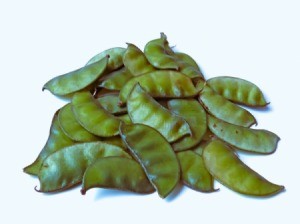 I have the most magnificent Hyacinth Bean vine, complete with beans now. How do I cook them, like snow peas? I know the leaves, flowers and beans are edible but when I sampled a flower, it had a pungently raw bean flavor. Is there a way to tame that strong flavor?
I have the most magnificent Hyacinth Bean vine, complete with beans now. How do I cook them, like snow peas? I know the leaves, flowers and beans are edible but when I sampled a flower, it had a pungently raw bean flavor. Is there a way to tame that strong flavor?

Hi Lynda,
Here's a link:
www.ces.ncsu.edu/
that says they are poisonous. I'm not sure if these are the same ones you have. Connie also says that dry seeds should be cooked with 2 changes of water before eating.
Here's another link:
forums.gardenweb.com/
That discusses them. It's hard to know but it might be that the poisons build up over time or the way you cooked them made them safe, or the kind you are growing aren't poisonous.
For all who are worried about hyacinth beans, I come from Africa and there we always eat the hyacinth beans, dry ones which are black with the white seam. Mayb they are a different sub group but believe me we eat them. My grand mother always said that the roots are poisonous but the dry bean is not or maybe our stomachs are different.
Warning"Dry seeds should be well cooked in two changes of water before eating. Raw dry seeds are poisonous and can cause vomiting, labored breathing, and even convulsions and unconsciousness."
I grow Hyacinth Beans for their beautiful flowers and pods only for looks. Everything i have read on them gives a huge warning of poisonous conditons handled the wrong way. My own personal opinion is that I would not eat them at all. Everything I have read on them post a big poisonous warning sign on eating them.
After posting my tip about the surprise of how wonderful the Hyacinth Bean is, I found this "warning" notice from someone, and wonder if all growers should be notified? All their growing tags say, "all parts edible". It has been 24 hours now, and I have not a single sign of distress, much less any kind of poisoning, and these beans could not taste better!
There is a Hyacinth water flower that may be poisonous. I've had those kinds of Hyacinths in my bog garden, but never been curious or tempted to eat any of them.) Perhaps someone could do more research on this issue? How could a garden center sell the bean as a flowering vegetable if it is poisonous? There were absolutely no warnings of this sort on the seed package. I have an organic garden so I am very cogniscent of such labels.
The information about growing Hyacinth bulbs is not the same information about eating hyacinth beans from the hyacinth bean vine. These are totally two different plants. Hyacinth plants that are sold in florist shops or grocery stores have huge stalky fragrant blooms, not at al related to the delicate Hyacinth bean vine.
Editor's Note: We do our best to check things but there are not enough hours in the day for us to do it all. That's why we have feedback and a contact form. I did check on this though and found evidence to support it.
OK, this research is being done very well, and after reading how many folks eat them and do not even get sick, I will consider them safe enough to eat. The GardenWeb site offered lots of input from others who cook and eat them.
I didn't drink the cooking water, and know that the common knowledge about cooking spinach is that it becomes toxic when cooked, yet, I still occasionally eat spinach and likely will continue learning how to just cook quickly and lightly saute, as I do the Hyacinth beans. One member mentioned that the Lima Bean is also toxic if not allowed to eliminate it's toxic gas through no-lid cooking?
I'm a "Princess and the Pea" with food sensitivity, and believe me, if the Hyacinth bean were lightly poisonous or worse, I would be the first to know. : )
I repeat, as in other feedback, that I am amazed at the whole plant! It is truly a delight and a wonder to grow. The seed pods are not too profuse, and I will hope to get more seed from one to plant for the Spring all around the fence row. I may also include the highly recommended Scarlet Runner, if there are lovely flowers promised as well.
LOL Thank you for taking the time to deal with this and to try to sort it out. When learning what is poisonous for my grandchildren in the way of plants, I was perplexed to learn that almost all plants we grow in and around our homes are absolutely poisonous to our children. We must be careful with all plants we eat or grow.
Have eaten the green flat beans! I grew Hyacinth for the first time this summer and love their beauty! I decided to cook and eat them after boiling them first and washing them after. Then sautéed them! So far am alive and no signs of any distress!
There is a very simple way to avoid mistaking a plant, it is to use its scientific name. It is also very useful to know the scientific name of a plant to do not buy at a high price a very common plant that you can find everywhere in the wild but is sold to you with a fancy name, for example, the invasive Physalis alkekengi sold under the names of Chinese lantern, Japanese lantern, bladder-cherry ...
About hyacinth beans (scientific name Lablab purpureus or Dolichos lablab L. or Dolichos purpureus) the pods and seeds are edible when green and fresh, but dry pods and dry seeds are toxic due to the concentrations of cyanogenic glycosides. Once dried, they can only be consumed after prolonged cooking (cyanogenic glycoside concentrates also in the kernels within the pits of apricots, cherries, peaches, pears, plums).
These beans are not poisonous. In the Caribbean, these beans are cooked and eaten on a daily basis. They are cooked with the pods, because very part of the bean is edible. I grow them every summer and they make a delicious meal. At Thanksgiving I cook them in the pressure cooker with ham hocks, just as you would prepare collard greens.